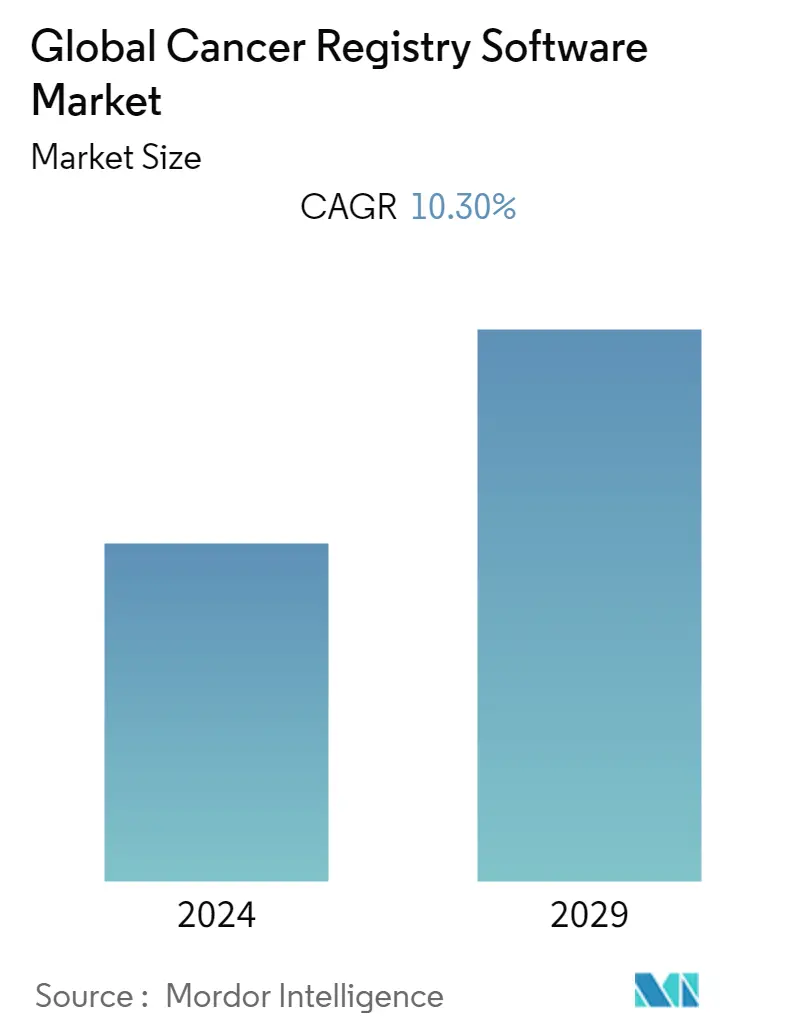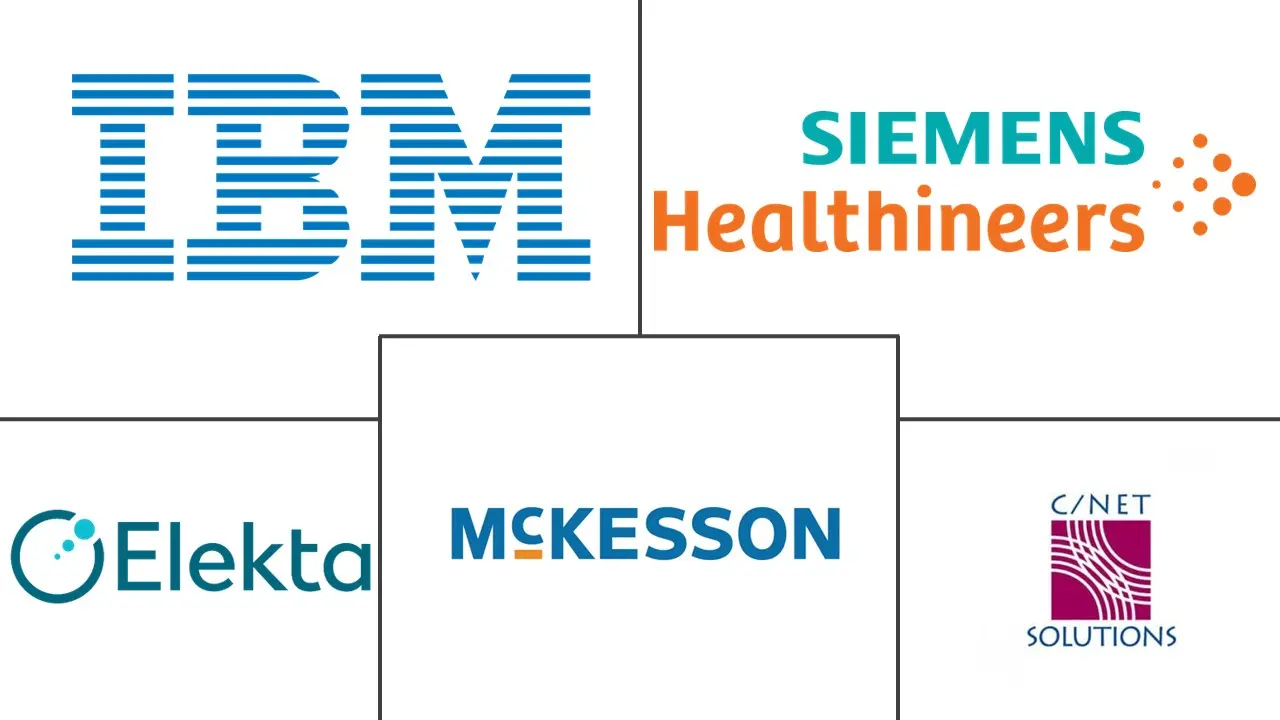Market Size of Global Cancer Registry Software Industry

| Study Period | 2019 - 2029 |
| Base Year For Estimation | 2023 |
| CAGR | 10.30 % |
| Fastest Growing Market | Asia-Pacific |
| Largest Market | North America |
| Market Concentration | Medium |
Major Players
*Disclaimer: Major Players sorted in no particular order |
Cancer Registry Software Market Analysis
The cancer registry software market is projected to register a CAGR of 10.3% during the forecast period 2022-2027.
Due to the COVID-19 pandemic, the diagnostics for cancer decreased significantly during the pandemic, and there has been a decline in chemotherapy, surgery, and other supportive treatments for cancer. Further, in June 2020, guidance was issued by the European Society of Gastrointestinal Endoscopy and the European Society of Gastroenterology and Endoscopy Nurses and Associates. The guidance document advised that doctors postpone post-endoscopic resection, surgical resection of cancer, and post-polypectomy cancer. They also advised that screening of high-risk patients for cancer should also be postponed due to the risk of infection, which further led to the reduction in the treatment procedures.
Similarly, in January 2022, a research study published titled "Impact of the COVID19 pandemic on populationbased cancer registry" stated that many cancer registries worldwide reported disruption to their operations during the early COVID19 pandemic. Governmental commitment to support future registry operations as an asset to disease control, alongside a move toward electronic reporting systems, will help to ensure the sustainability of cancer surveillance worldwide.
Factors such as increasing prevalence of cancer, and improving quality of care, and reducing healthcare costs coupled with recent developments by key players such as product/service launches and mergers & acquisitions are expected to increase the market growth in the upcoming future. According to the Global Cancer Observatory (Globocan) 2020 statistics, Globally, there were 19.3 million new cancer cases in 2020, these cases are expected to increase and reach up to 30.2 million in 2040. Additionally, according to estimates from the International Agency for Research on Cancer (IARC) updates from July 2021, by 2040, the global burden of cancers is expected to grow to 27.5 million new cancer cases and 16.3 million deaths worldwide. Such high burdens will increase the demand for cancer registry software as it would provide significant advantages to identifying the trend related to the prevalence and treatment of cancer.
Similarly, product approval and launches are other factors for the growth of the market. For instance, in April 2020, Elekta received a CE mark for its ProKnow cloud-based retrieval and storage software. With vendor-neutral ProKnow, any radiation therapy department can securely upload massive volumes of data to ProKnow's cloud server for storage, distributed contouring, plan evaluation and peer review, and analysis of key metrics - including outcomes technique evaluations and intra- and inter-institutional collaborations.
Additionally, in August 2021, IARC, The Northern Ireland Cancer Registry, and new software to facilitate cancer staging, aiming to improve national cancer control with a more effective collection of comparable data. Furthermore, in October 2020, MOVEMBER launched the world's largest network of prostate cancer patient registries, which will have the power to transform treatment and care of the disease by harnessing the 'real world' experiences of over 130,000 men. Such initiative improves the infrastructure and brings the cost down by providing a more efficient and cost-effective digital solution. Hence, due to the abovementioned factors, the market is expected to grow in the future. However, privacy and security concerns for patient data will be a restraint in the market growth.
Cancer Registry Software Industry Segmentation
As per the scope, cancer registry software is an information system designed for the collection, storage, and management of data on persons with cancer. The Cancer Registry Software Market is Segmented by Deployment Model (On-Premise, and Cloud-based), Database Type (Commercial Database and Public Database), End Use (Government & Third Party, Private Payers, Hospital & Medical Practice, and Others), and Geography (North America, Europe, Asia-Pacific, Middle-East and Africa, and South America). The market report also covers the estimated market sizes and trends for 17 different countries across major regions globally. The report offers the value (in USD million) for the above segments.
| By Deployment Model | |
| On-Premise | |
| Cloud-based |
| By Database Type | |
| Commercial Database | |
| Public Database |
| By End Use | |
| Government & Third Party | |
| Private Payers | |
| Hospital & Medical Practice | |
| Others |
| Geography | ||||||||
| ||||||||
| ||||||||
| ||||||||
| ||||||||
|
Global Cancer Registry Software Market Size Summary
The cancer registry software market is poised for significant growth, driven by the increasing prevalence of cancer and the need for improved healthcare solutions. The market is expected to expand due to advancements in technology and the adoption of electronic reporting systems, which enhance the efficiency and accuracy of cancer surveillance. The COVID-19 pandemic initially disrupted cancer diagnostics and treatment, but it also highlighted the importance of robust cancer registry systems for future disease control. Key players in the industry are focusing on product launches, mergers, and acquisitions to strengthen their market position. The availability of cancer registry software in hospitals, coupled with rising cancer-related procedures, is further propelling market growth. Hospitals, with their well-developed infrastructure, are becoming primary care centers for cancer patients, which is expected to continue in the foreseeable future.
North America is anticipated to dominate the cancer registry software market, driven by the high prevalence of chronic disorders like cancer and the introduction of new products. The growing burden of cancer cases in the United States and Mexico is expected to fuel market expansion in these regions. The adoption of cancer registries is increasing, with a significant number of registries utilizing advanced software solutions to streamline operations and meet data exchange standards. The market is partially fragmented, with major players such as CET Solutions, Elekta, McKesson Corporation, IBM Corporation, and Siemens Healthineers leading the way. Strategic partnerships and collaborations, like those between Kaiku Health and Roche, are enhancing digital patient monitoring and management, further supporting personalized cancer care. As technological advancements continue, the market is likely to see increased penetration in developing countries, contributing to its overall growth.
Global Cancer Registry Software Market Size - Table of Contents
-
1. MARKET DYNAMICS
-
1.1 Market Overview
-
1.2 Market Drivers
-
1.2.1 Increasing Prevalence of Cancer
-
1.2.2 Improving Quality of Care and Reducing Healthcare Costs
-
-
1.3 Market Restraints
-
1.3.1 Privacy and Security Concerns for Patient Data
-
-
1.4 Porter's Five Forces Analysis
-
1.4.1 Threat of New Entrants
-
1.4.2 Bargaining Power of Buyers/Consumers
-
1.4.3 Bargaining Power of Suppliers
-
1.4.4 Threat of Substitute Products
-
1.4.5 Intensity of Competitive Rivalry
-
-
-
2. MARKET SEGMENTATION (Market Size by Value - USD million)
-
2.1 By Deployment Model
-
2.1.1 On-Premise
-
2.1.2 Cloud-based
-
-
2.2 By Database Type
-
2.2.1 Commercial Database
-
2.2.2 Public Database
-
-
2.3 By End Use
-
2.3.1 Government & Third Party
-
2.3.2 Private Payers
-
2.3.3 Hospital & Medical Practice
-
2.3.4 Others
-
-
2.4 Geography
-
2.4.1 North America
-
2.4.1.1 United States
-
2.4.1.2 Canada
-
2.4.1.3 Mexico
-
-
2.4.2 Europe
-
2.4.2.1 Germany
-
2.4.2.2 United Kingdom
-
2.4.2.3 France
-
2.4.2.4 Italy
-
2.4.2.5 Spain
-
2.4.2.6 Rest of Europe
-
-
2.4.3 Asia-Pacific
-
2.4.3.1 China
-
2.4.3.2 Japan
-
2.4.3.3 India
-
2.4.3.4 Australia
-
2.4.3.5 South Korea
-
2.4.3.6 Rest of Asia-Pacific
-
-
2.4.4 Middle-East and Africa
-
2.4.4.1 GCC
-
2.4.4.2 South Africa
-
2.4.4.3 Rest of Middle-East and Africa
-
-
2.4.5 South America
-
2.4.5.1 Brazil
-
2.4.5.2 Argentina
-
2.4.5.3 Rest of South America
-
-
-
Global Cancer Registry Software Market Size FAQs
What is the current Global Cancer Registry Software Market size?
The Global Cancer Registry Software Market is projected to register a CAGR of 10.30% during the forecast period (2024-2029)
Who are the key players in Global Cancer Registry Software Market?
C/NET Solutions, IBM Corporation, Siemens Healthineers, McKesson Corporation and Elekta are the major companies operating in the Global Cancer Registry Software Market.

